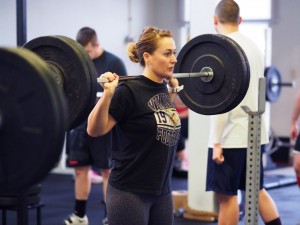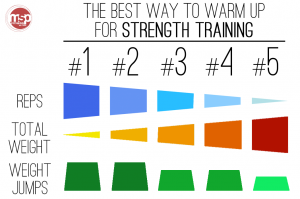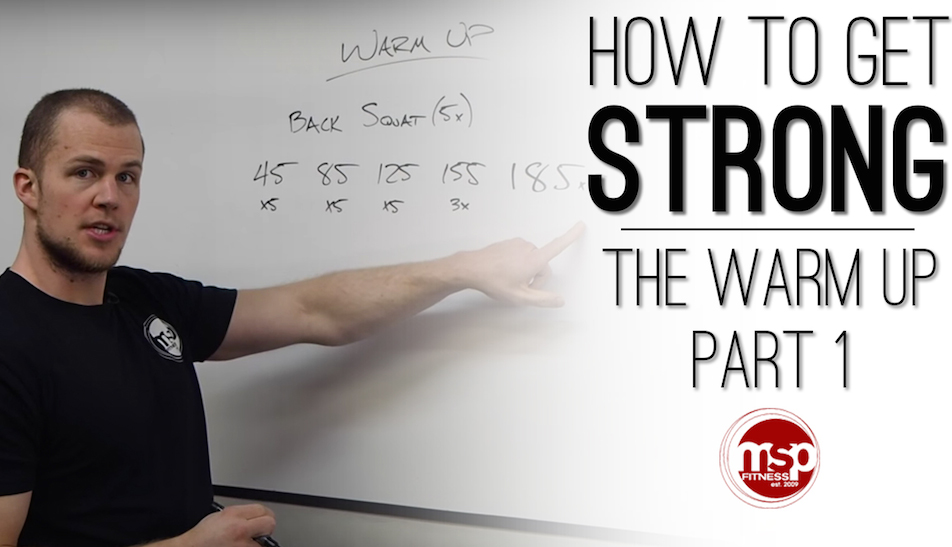Welcome everyone. This is the first of a multi-part series on progressing in strength training. During this video blog series on strength, we’re going to be answering questions like…
1. Why am I not getting better with my barbell movements? AND
2. How do I get stronger over a long period of time?
Today we are going to talk exclusively about the warm-up. In doing so, I have to first qualify that when we say warm up, this is not your movement prep, your mobility work, or your general preparation before training. For the scope of this video blog, we are acting on the presumption that you are already warmed up and have done some pre-training movement prep. For our Back Squat example today, I am also taking the liberty that you know how to Back Squat. If not, we have demonstration videos over on our YouTube Channel that will bring you up to speed. That being said, let’s move on.
The Warm Up:
 In today’s example we are going to use a scenario where someone is warming up to their first work set of Back Squat for five repetitions. For the sake of consistency in our example, let’s put the goal for this individual’s first work set at 185 lbs. Five reps at 185 has to start somewhere, and in strength training it’s always beneficial to remember that we don’t begin with zero, but rather the weight of the implement. In this case that’s a men’s barbell weighing 45 lbs.
In today’s example we are going to use a scenario where someone is warming up to their first work set of Back Squat for five repetitions. For the sake of consistency in our example, let’s put the goal for this individual’s first work set at 185 lbs. Five reps at 185 has to start somewhere, and in strength training it’s always beneficial to remember that we don’t begin with zero, but rather the weight of the implement. In this case that’s a men’s barbell weighing 45 lbs.
While it might be convenient to simply load the bar up with those nearby 25’s or 45’s, making the barbell 95 or 135 total pounds respectively, I am unfortunately here to tell you that the convenient choice isn’t always the correct choice. If you were following along with the mental math, that would mean the initial jump to 95 (50 lb increase) and then to 135 (40 lb increase on top of 95) leads to a series of jumps that progress in poundage versus decrease (see image below), which is less than ideal.

When adding weight to your warm ups, you always want your load increases be smaller than their predecessor. I would instead encourage you to take the road often less traveled and jump from a set at the empty bar to a set at 85 lbs (40 lb increase right off the bat). It is then only logical to make another 40 lb jump to 125 total pounds. This would leave your smallest increases in load for your last warm up when you bump things up 30 lb to 155 lbs, and then the final 30 lb push to your first work set at 185 total pounds.

How many reps do I do on each warm up set?
What we do for repetitions on each warm up set is simply dictated by the day’s rep agenda. Once again, in our current scenario using 185 lbs as our target, that’s five repetitions. I’m going encouraged people to always hit the full rep range on that initial warm up with the bar and the first few warm up sets thereafter. It is only on the last warm up or the second to last warm up set that we’d take a few less reps depending on how the individual is feeling, or how things are looking in the coach’s eye. For today’s example, a day of five repetitions, I’d make my second to last or last warm up a set somewhere in the three rep range. Warming up five reps on 155 lbs is quite a bit of labor considering its percentage of the initial work set of 185 lbs. I wouldn’t want to pre-fatigue myself (or my client) by performing a relatively heavy set of five right before my first work set. Instead, we’ll take a “primer” set right before the real work begins.

For other training scenarios where 185 lbs is not the number of your first set, all the same rules apply. I am always going to pyramid up my weights up, while conversely downscaling my volume in the form of repetitions. You might be asking, “What if I have to do more reps?” Great question! Nothing we’ve laid out is altered, even if the rep range changes to six, seven, or ten plus. You will still downscale the amount of reps on the warm ups as the load increases.
One situation where things change slightly is if  you are performing work sets with less repetitions. One constant component of strength training is the shorter the workout, the longer the warm-up. Practically, this is simply increasing the total number of warm up sets.
you are performing work sets with less repetitions. One constant component of strength training is the shorter the workout, the longer the warm-up. Practically, this is simply increasing the total number of warm up sets.
This has been our video / blog on how to progress your strength training. If you haven’t see the correlating video, scroll up to the top of this page where it’s imbedded or click here. We’re always curious as to how you applied the knowledge gained in these videos, join the conversation on Facebook and let us know how it went! Also make sure you check out part two on how to progress the loads through multiple work sets AND a final posting on progressing week after week after week, leading to gains for years on end.
-Written by Michael S. Pilhofer and Taylor Gish
We at MSP Fitness feel passionately that under a proper training program, you never have to plateau. If you are in the Minneapolis / St. Paul area and are looking for a coach who can help you reach your strength, health, and wellness goals, CONTACT US today!


